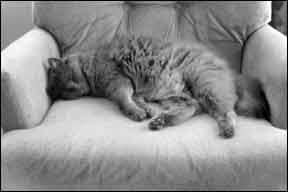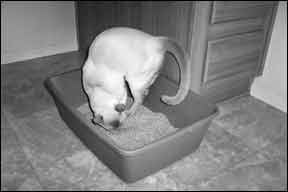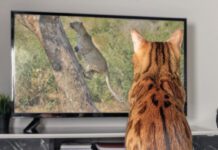Thanks to advances in all fields of veterinary medicine, it is not uncommon these days for a cat to live to the very ripe old age of 20 — roughly the physiologic equivalent of age 93 in a human. That’s the good news.

288
The bad news is that cats, like humans, become increasingly susceptible to age-related disease conditions as they grow old, and most of these disorders are bound to have an effect on an animal’s behavior. Arthritis, for example, is likely to cause a formerly rambunctious cat to slow down dramatically as it transitions through its so-called golden years; kidney and urinary tract disease may severely affect its litter box behavior; progressive periodontal disease and tooth loss may alter its eating habits; and progressive hearing problems may make a cat decreasingly responsive to its environment.
In some cases, however, an elderly cat’s behavioral peculiarities will — despite thorough veterinary examination and laboratory testing — remain unattributable to any underlying disease condition. In such a case, the animal is apt to be diagnosed as “senile,” a vague term used to describe an animal that exhibits physiologically inexplicable cognitive dysfunction, the outward signs of which somewhat resemble those associated with age-related dementia and Alzheimer’s disease in humans.
Feline senility is by no means uncommon. Indeed, one study has shown that as many as 80 percent of cats over the age of 16 years show signs of the condition, often associated with post mortem changes in their brains (such as beta amyloid plaques) that are seen in the brains of humans with Alzheimer’s disease and senile dementia.
Signs of Senility. The clinical signs of feline senility — which can become noticeable in cats as young as 10 years of age — vary from animal to animal and are not exclusively associated with age-related dementia. They include spatial disorientation; wandering in unfamiliar territory; diminished playfulness; excessive sleeping; shifting patterns in cycles of sleep and wakefulness; long periods of staring into space or at walls; indifference to food and water; sudden, prolonged and seemingly unprompted vocalization; and elimination outside the litter box.
According to Katherine Houpt, VMD, PhD, the emeritus James Law Professor of Animal Behavior and director of the Behavior Clinic at Cornell University’s College of Veterinary Medicine, the most dramatic and most frequently reported behavioral indication of feline senility is an elderly cat’s persistent vocalization during the night. “They howl and screech constantly between midnight and dawn,” says Dr. Houpt. “That’s the behavior that owners complain about the most. People usually don’t mind if a cat is just active at night. But the constant yowling keeps them awake, and that’s why we hear about it so often.”
Why would this strange vocalizing behavior occur in elderly cats that have no apparent underlying health issue, like hyperthyroidism? “It’s probably anxiety,” Dr. Houpt surmises. “There may be something like the fear of death at the base of it. They don’t feel quite right, and they can’t do anything about it. We don’t know why this occurs at night, but that’s when old dogs and, for that matter, old people also become anxious.”

288
Another behavioral indication that may, in the absence of an underlying disease, be considered a sign of senility is a change in the animal’s socializing patterns. “Certainly,” says Dr. Houpt, “senile cats do tend to withdraw from other cats. For instance, a cat that may have always slept with another cat may stop doing that. On the other hand, while senile dogs tend to become less affectionate with their owners, old cats usually become more affectionate.” As they age, she points out, they tend to become increasingly “clingy,” increasingly willing to lie purring in an owner’s lap for extended periods of time.
Erratic litter box behavior is a confusing issue, says Dr. Houpt, because it often occurs in geriatric cats with diagnosed diseases as well as in those for which this behavior may be a sign of senility. “House-soiling due to cognitive dysfunction in old cats almost always involves defecation,” she points out. “They’ll often go to their box to urinate, and they’ll do that. But then they’ll defecate outside the box. We don’t know why they do this. Obviously, it’s not an arthritic problem, since they’re able to get into the box to urinate.”
Cognitive Dysfunction? It may be presumed that older cats, like humans, can experience a decline in their mental processes due to age-related degeneration of their brain tissue. But feline senility remains largely a mystery. While an old cat may show signs of confusion, lack of interest and odd behavior, there is no way objectively to assess a decline in its cognitive functions — that is, there are no standards comparable to those that are used for assessing creativity and the use of language as a means of diagnosing human cognitive dysfunction.
“The problem,” says Dr. Houpt, “is that we don’t train cats to do anything. Probably the only cognition problem that a cat owner would pick up would be an animal’s inability to find its food dish. And this, of course, could simply be due to a lack of perception. Maybe the old cat’s eyesight is weak. Or if it doesn’t respond to you, maybe that’s because it can’t really hear you anymore.”
Giving Comfort. Certain measures might help prevent or delay the onset of senility, says Dr. Houpt, while others will ease the discomfort of an already affected cat. For example, she suggests that cats 15 years of age and older be fed a diet rich in vitamin E, carnitine (found in meat, dairy products and seeds) and antioxidants, substances that are known to retard the effects of aging. Such diets are readily available without a prescription. “These substances seem to be protective and to some extent curative,” she says. “I would certainly feed them to an old cat as long as there is no medical reason for its having to be on a different kind of diet.”
Also, she advises, owners should try to reduce stress in an aging cat’s daily life. “Don’t bring another cat or a dog into the household,” she says. “This can be very stressful during this period of an animal’s life.” If the aging cat has trouble going up stairs or jumping onto a bed, she suggests providing a ramp to help the animal. And make sure that its litter box is readily accessible and that the animal can get in and out of it easily.
Take the cat to the vet for routine checkups. If its unusual behavior is due to an underlying illness, the veterinarian can recommend treatment. If senility is diagnosed, the veterinarian may recommend medications to ease the signs.



